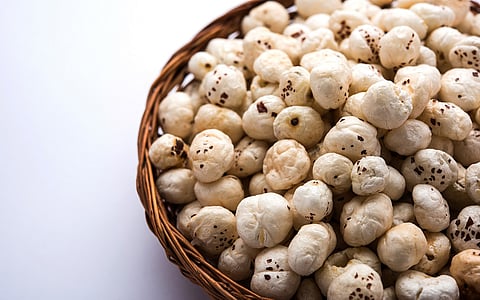Instead of heavy ‘attention’, makhana needs some ‘space’
Makhana, also known as ‘fox nut’, has emerged as one of India’s most talked-about superfoods in recent years. With its rich nutritional profile, aesthetic appeal, and multiple health benefits, the humble seed from Bihar has earned global recognition as a true treasure. The geographical area of Bihar, particularly North Bihar, has long been the heart of its production. In fact, prolonged issues of floods in the region have inadvertently turned makhana into a blessing in disguise, as it assisted farmers recover losses and rejuvenate the local economy.
Named as a ‘superfood from Bihar’, the makhana’s appeal skyrocketed after it received the Geographical Indication (GI) tag as ‘Mithila Makhana’ in April 2022, a certification that marked its uniqueness and authenticity. This recognition attracted an influx of entrepreneurs, start-ups, and traders, all eager to tap into the growing global market. The surge in demand, however, has led to a major supply-demand imbalance, pushing prices to unprecedented levels.
Existing challenges
While demand for the makhana continues to soar, its supply remains limited due to several critical challenges. The production process is highly labour-intensive, with minimal mechanisation. Harvesting makhana requires highly skilled labour, traditionally sourced from the Mallah community which constitute about 2.5 per cent of Bihar’s population. However, questions loom over the sustainability of this skilled labour force. The younger generation of the Mallah community, who have historically inherited these skills, may not continue the practice, further complicating the situation.
The reliance on manual labour, combined with a lack of modernisation in farming techniques, constrains production capacity and limits scalability. This has resulted in rising prices, sometimes soaring by as much as 80 per cent, creating volatility in the market. At the same time, producers—largely farmers—are not reaping the benefits. There are very limited examples of farmers having received high price spread (producer’s share in consumer’s rupee) as compared to the traders.
The GI tag for Mithila Makhana, granted to 21 districts in Bihar, has undoubtedly raised the profile of this valuable commodity. However, a closer look at the figures reveals a disconnect between the GI tag and its real-world impact on the producers. According to the GI registry, only 67 authorised users are registered under the GI tag—surprisingly, the majority of them are based in Kishanganj, while Darbhanga, Madhubani, and Sitamarhi are among the primary production centres.
For a commodity which has about 70,000 primary producers, such small number of authorised users, are not going to promise the economic benefits. As a result, the benefits intended for the local community are not trickling down as they should. Moreover, the absence of a proper traceability mechanism, like, HSN code for makhana, further complicates efforts to maintain trust and transparency in international markets. While as per government data, India exports only 200 million tonnes of makhana, without clear traceability, maintaining consumer confidence, especially in global markets, remains a significant challenge.
Policy interventions
Given the rising interest in makhana, it is imperative to ensure that local farming communities benefit from this surge in demand. First and foremost, the government must provide price guarantees to growers to shield them from market volatility. Without such safeguards, farmers risk being left behind as trader lobbies continue to control much of the business. Price regulations and fair-market regulations should be introduced to protect producers’ share in the consumer rupee.
Furthermore, there needs to be a concerted effort to register all genuine producers under the GI tag. The current system, with only 67 authorised users, does not reflect the actual scale of makhana production in Bihar. Expanding the registration process to include more genuine producers—especially from the primary production hubs like Darbhanga, Madhubani, and Sitamarhi among others will ensure that the benefits of the GI tag flow to the grassroots level and community development takes place.
Lastly, the government must intervene to regulate the influx of market entrants to prevent the formation of monopolies or price manipulation by powerful lobbies. With too many players entering the market, the risk of exploiting producers increases, which could lead to a situation where farmers receive an even smaller share of the profits. A balanced, fair-market approach, with active government regulation, is necessary to ensure that makhana remains a boon for both producers and consumers.
Makhana is undeniably a superfood with immense potential. But to ensure that it remains a blessing for the farmers who grow it, and not just a commodity for other stakeholders, serious reforms are needed. This includes better price guarantees for farmers, expansion of the GI tag registration to include all genuine producers, and a system to ensure traceability for export. Without these interventions, the rise of makhana could become a fleeting success story, leaving producers behind as mere spectators in the face of rapid commercialisation.
Mohit Sharma is Faculty of Agribusiness at Dr. Rajendra Prasad Central Agricultural University, Bihar
Views expressed are author’s own and do not necessarily reflect that of Down To Earth


